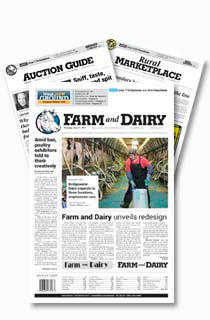Farmers and ranchers live in an ocean of numbers. And like the tide, the numbers – pigs-per-litter, gain-per-pound, bushels-per-acre, dollars-per-bushel – can’t be held back; they keep coming and keep adding to our nation’s food story.
The U.S. Department of Agriculture swells the tide with its raft of annual, quarterly, monthly, biweekly, weekly and daily reports.
The data are the dots by which all in agriculture and food steer. And the steering is about to get harder.
Not big enough. Two late August USDA reports confirm that 2006’s big numbers won’t be big enough for American food producers.
At first blush the first report, the Outlook for U.S. Agricultural Trade, released Aug. 23, looked lovely; estimated 2006 ag exports will be a record-breaking $68 billion, besting 2005’s record-breaker by a fat $5.5 billion, or nearly nine percent.
Secretary of Agriculture Mike Johanns waived the report high to again push the White House’s trade-is-everything view of agriculture.
“These exports numbers clearly illustrate the importance of opening and maintaining export markets for U.S. agriculture products,” said a smiling Johanns after the report’s release.
Rise and fall. But, as he often does, Johanns only highlighted the best and forgot the rest.
Yes, grain and feed exports will climb from $16.2 billion in 2005 to $18.1 billion in 2006.
But soy and soy product exports will slide from $11 billion to $10.2 billion over the same period.
Yes, our neighbors Mexico and Canada will up their collective U.S. ag imports from $19.5 billion in 2005 to $21.9 billion, or from 31 percent of all U.S. ag exports in 2005 to 32 percent in 2006.
But so too will these two nations export more food back into the U.S. – from $19.9 billion in 2005 to $22.8 billion this year.
Facts. Consider these facts for a moment: One nation, Mexico, with one-third our population, one-tenth our economy and one-fourth our per capita income will combine with another nation, Canada, with one-one-tenth our economy and one-ninth our population to sell us 35 percent of all our imported food. Thanks, NAFTA.
This theme – yes, total 2006 ag export will grow 8.8 percent over 2005, but total ag imports will grow by an even bigger 11.8 percent – can be seen on nearly every page of the USDA report yet nary of word of this downward trend ever passes the USDA chief’s lips.
The reason, of course, is simple. These USDA facts neither fit the administration’s unending trade sermon nor its election year slogans. Nor do the facts contained in USDA’s Aug. 31 forecast on 2006 farm income.
That report shows 2006 estimated net farm income at $54.4 billion, or nearly $20 billion under 2005’s $74 billion and $31 billion under 2004’s $85.4 billion.
Black flags. Indeed, everywhere you look in the income report you see black flags and bleak numbers when comparing 2005 to 2006 in farm country: gross cash income down from $281 billion to $272 billion; livestock receipts down from $125 billion to $119 billion; direct government payments down from $24 billion to $18 billion; total expenses up from $226 billion to $237 billion.
The one thing you won’t find in the income report and its accompanying analysis is a press release or even a public comment by Johanns on how farm income has crashed under his leadership.
Again, these USDA facts neither fit the administration’s unending trade sermon nor its election year slogans. Golly, record ag exports and a simultaneous $20-billion plunge in net farm income and no public official offers one word of explanation?
Indeed, the reports’ facts plainly show the administration’s – as well as many farm groups’ – central “market access” plank to both the 2007 farm bill debate and world trade talks is, again, all gas.
What’s more, if you restate annual ag trade numbers from 1990 through 2006 in constant 2006 dollars you quickly see the U.S. ag trade surplus peaked in mid-1996 at $35 billion and steadily eroded to today’s $3 billion.
Odyssey. And what seminal American ag event occurred in 1996?
We embarked on an odyssey in ag policy, Freedom to Farm, that has yet to work. Just look at the numbers.
(Alan Guebert’s Farm and Food File is published weekly in more than 75 newspapers in North America. He can be reached via e-mail at agcomm@sbcglobal.net.)













